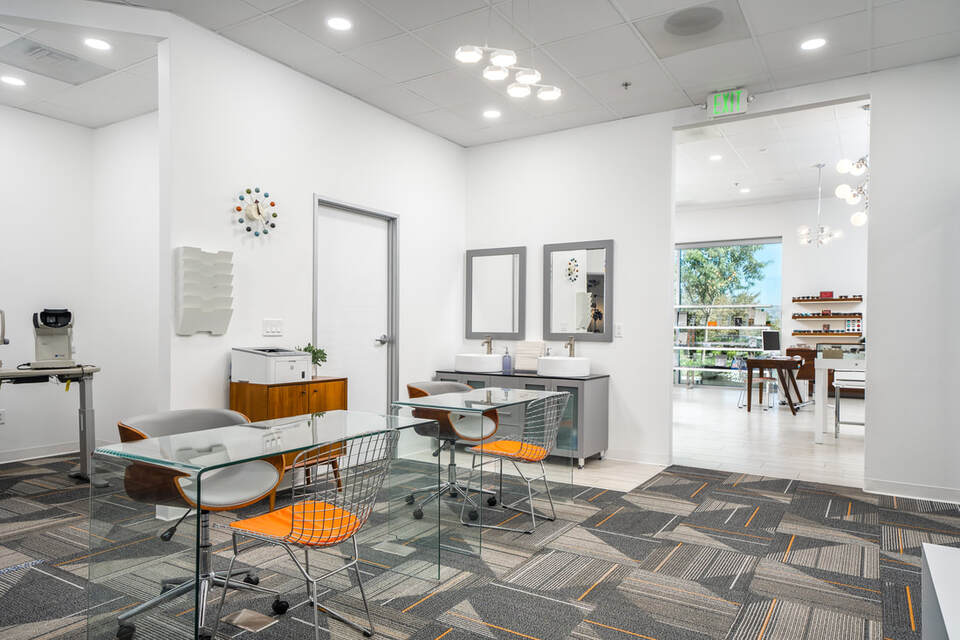Contact Lenses
Contact lenses, like eyeglasses or refractive surgery, can correct your nearsightedness, farsightedness, and astigmatism. Of the people who need vision correction in the United States, about one in five wear contact lenses.
While some people enjoy the fashion statement of eyeglasses, others prefer their appearance without them. Contact lenses can achieve this without irreversible surgery. Contact lenses can also provide a full field of unobstructed vision, which is good for participation in sports.
Contact lenses have been around for more than 100 years. During that time, many advancements have been made that allow just about everyone to wear contact lenses. If you were told in the past that you couldn't wear contact lenses, odds are that's not true today. There are more convenient and healthy contact lens options than ever.
If you're new to contact lenses, your first step is to see an eye doctor. In the United States, contact lenses are a prescription item, just like pharmaceuticals. They must be prescribed and properly fitted by an eye care professional (ECP). Your ECP will evaluate your visual needs, your eye structure, and your tears to help determine the best type of lens for you.
The many types of contact lenses currently available:
- What they're made of
- How long you wear them without removal
- How often you dispose of them
- The design of the lens
- Contact Lens Materials
- Daily disposable replaced every day
- Disposable (used for daytime wear) replaced every two weeks
- Disposable (used for overnight wear) replaced every week
- Continuous wear (used for 30-day wear) replaced monthly
- Planned replacement replaced monthly or less frequently
- Contact Lens Designs
Many lens designs are available to correct various types of vision problems:
- Spherical contact lenses are the typical, rounded design of contact lenses, which can correct myopia (nearsightedness) or hyperopia (farsightedness).
- Bifocal contact lenses contain different zones for near and far vision to correct presbyopia, which is the age-related, decreased ability to obtain a full range of vision.
- Orthokeratology lenses are specially designed to reshape the cornea during sleep, providing lens-free daytime wear.
- Toric contact lenses correct for astigmatism, as well as for myopia and hyperopia.
Lenses can be custom made for hard-to-fit eyes. Many other additional lens designs are available. Typically these are less common and fabricated for use in special situations, such as correcting for keratoconus.
More Contact Lens Features
- Colored Lenses. Many of the types of lenses described above also come in colors that can enhance the natural color of your eyes that is, make your green eyes even greener, for example. Or these lenses can totally change the eye's appearance, as in from brown to blue.
- Special-Effect Lenses. Also called theatrical, novelty, or costume lenses, these take coloration one step further.
- Prosthetic Lenses. Colored contact lenses can also be used for more medically oriented purposes. People with disfigured eyes, as a result of accidents or disease, can use a custom, opaque colored lens to mask the disfigurement and match the appearance of their normal eye.
- Custom Lenses. If conventional contact lenses don't seem to work for you, you might be a candidate for a customized design.
- UV-Inhibiting Lenses. Today, many contacts incorporate an ultraviolet blocker in the lens material, to cut down on UV light that can eventually cause cataracts and other eye problems. You can't see this blocker by looking at the lens. And since contacts don't cover your entire eye, UV blockers cannot substitute for traditional sun protection like good quality sunglasses.
- Hybrid Lenses. One brand of lenses features a GP center with a soft outer skirt, providing wearers with both the crisp optics of a rigid lens and the comfort of a larger, soft lens.
Contact Lens Wear and Care
Caring for your contact lenses cleaning, disinfecting and storing them is much easier than it used to be.
A few years ago, you would have needed several bottles of cleaning products, and perhaps enzyme tablets, for proper care. Today, most people can use "multipurpose" solutions meaning that one product both cleans and disinfects, and is used for storage. Some people who are sensitive to the preservatives in multipurpose solutions might need preservative-free systems, such as those containing hydrogen peroxide.
Of course, you can avoid lens care altogether by using daily disposables.

Quality of life is so important. How does your child see the world? Make sure they see it clearly and vibrantly. Orthokeratology or ortho-k or are special contacts your child wears only while they sleep. Your child will remove the lenses in the morning for clear vision without having to wear glasses or other daytime vision correction! Imagine the
freedom! Learn more by making an appointment.

If you have Keratoconus or any other condition caused by having corneal irregularities, you likely know that soft contact lenses are rarely an option and rigid gas permeable lenses may shift, distorting vision and reducing comfort. Onefit™ scleral lenses on the other hand are custom designed to the unique shape of YOUR eye- vaulting the cornea and creating a new smooth, regular surface for clear vision and stability on the eye. They also provide a cushion of tears for unparalleled comfort, eye health and vision performance. Contact us today to learn more about these life changing lenses.


